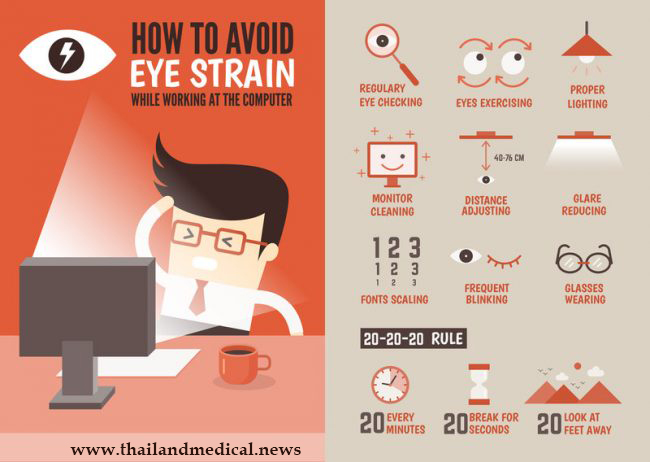Source: Thailand Medical News Oct 15, 2019 6 years, 2 months, 2 weeks, 4 days, 4 hours, 18 minutes ago
As a result of the technology and digital explosion, more workers need to be spending their time looking at computer screens each day with most spending at average of at least 5 hours per day during their daily work hours. As a result of that, the incidence of Computer Vision Syndrome of CVS is on a steady rise. The prevalence of computer vision syndrome(CVS) among computer users was 69.5 %. Blurred vision, eyestrain, and eye irritation were the most common reported symptoms of CVS with prevalence of 62.60%, 47.63%, and 47.40%, respectively.
CVS or digital eye strain is a group of eye and vision problems. The problems can include eyes that itch and tear, and are dry and red. One’s eyes may feel tired or uncomfortable.One may not be able to focus normally. These problems are caused by too much computer or digital device use. Using e-readers and smart phones may also cause these problems.
These problems have been increasing in frequency over the past few decades. Many people have some symptoms if they use a computer or digital device for long periods. Most computer or digital device users have symptoms at least some of the time. Digital eye strain is very common in both children and adults.
Causes Of Computer Eye Syndrome
For many reasons, reading text on a computer screen or digital device is often harder for the eyes than reading printed text. This is why working on a computer for a few hours might cause eye problems. But reading a book may not.
Several factors help to cause digital eye strain, such as:
- Screen glare
- Poor lighting
- Poor posture while using a computer
- Viewing a computer at the wrong distance and angle
- Uncorrected vision problems
- A mix of these things
Individuals often blink less when using a computer than when reading printed text. This can cause dry eye. That can also help to cause digital eye strain.
Risk For Getting Computer Eye Syndrome
One may be at greater risk for digital eye strain if one:
- Spend a few hours a day at a computer or on a digital device
- Are too close to your computer or digital device screen
- View your computer or digital device at the wrong angle
- Have bad posture while using your computer or digital device
- Have eye problems (even minor ones) not corrected with glasses or contact lenses
- Have a pair of glasses that is not suitable for viewing the distance of your computer
- Don’t take breaks while you are working
One may have an underlying problem with dry eye. This may make digital eye strain worse. Or it can make it more likely to occur.
Dry eye is more common in women than in men. It also becomes more common with age. Some
medicines and health problems make dry eye more likely. For example, if you use antihistamines, you may be at greater risk of having dry e
ye. If you have thyroid disease or certain autoimmune diseases, you are also at greater risk of having dry eye.
Symptoms Of Computer Eye Syndrome
Computer Eye Syndrome can cause many symptoms, including:
- Blurred vision
- Double vision
- Dry eye
- Eye discomfort
- Eye fatigue
- Eye itching
- Eye redness
- Eye tearing
- Headaches
- Neck and shoulder pain
Most of these symptoms are short-term (temporary). They lessen or go away when you stop using your computer or device. But sometimes you may have symptoms for a long time afterward.
The severity of symptoms may vary depending on:
- How long you have been using the computer or digital device
- Your underlying eye problems
- Other factors that cause digital eye strain.
Symptoms may get worse if you don't resolve the problem.
Using a computer or digital device for a long time can also lead to other symptoms. This includes neck and shoulder pain. This is often due to poor alignment and posture when using the computer or digital device. Some healthcare providers call these symptoms part of digital eye strain as well.
Diagnosis of Computer Eye Syndrome
Your eye doctor or ophthalmologists will make a diagnosis with a health history and complete eye exam. He or she will assess if any health problems, medicines, or environmental factors might be adding to your symptoms.
Your eye doctor may test the sharpness of your vision and how well your eyes focus and work together. In some cases, the provider may want to dilate (enlarge) your pupils. Then he or she will use a device (ophthalmoscope) to look at the back of your eye. In some cases, you may need to get follow-up blood tests for healthcare problems that might be helping to cause your digital eye strain.
Treatments For Computer Eye Syndrome
Treatment includes creating a better work environment.
- Rest your eyes at least 15 minutes after each 2 hours of computer or digital device use.
- Every 20 minutes, look into the distance at least 20 feet away from the computer or digital device. Do this for at least 20 seconds.
- Enlarge the text on your computer screen or digital device.
- Minimize glare from the light sources in your environment.
- Think about using a screen glare filter.
- Place your screen so that the center of it is about 4 to 5 inches below eye level (about 15 to 20 degrees from the horizontal).
- Place your screen about 20 to 28 inches from your eye.
- Remember to blink often.
- Fix your chair height so your feet can rest comfortably on the floor. Don’t slump over the computer screen.
Making these changes gets rid of digital eye strain in many people.
Your eye doctor will also need to treat any hidden health problems that may be helping to cause your digital eye strain. For example, you might need a new pair of glasses. If you have an underlying dry eye problem, your eye care provider might advise the following:
- Using lubricating drops
- Treating allergies, if you have them
- Creating a more humid work environment
- Drinking more fluids (staying hydrated)
- Taking a prescription medicine to increase tear production
Ways to Prevent Computer Eye Syndrome
Create a better work environment to help prevent digital eye strain. If you use glasses or corrective lenses, see your eye care provider at least once a year or as advised for a checkup. Also see your healthcare provider regularly. This can help prevent and treat health problems that can help cause digital eye strain.
Key points about digital eye strain
- Digital eye strain is a group of related eye and vision problems caused by extended computer or digital device use.
- Symptoms include eye discomfort and fatigue, dry eye, blurry vision, and headaches.
- Uncorrected vision problems are a major cause.
- Sometimes hidden health problems help to cause it.
- Having a better computer work environment can help stop most people’s symptoms.
- Resting your eyes regularly is one of the best ways to prevent and treat digital eye strain.
Conclusion
Thailand Medical News recommends that one should also try to avoid continuing using digital devices after working hours. Give your eyes sufficient time to rest. Avoid unnecessary usage of smartphone and tablet devices unnecessary and most important, avoid using any digital devices at least 90 minutes prior to bedtime as blue light emissions from these devices can have a


